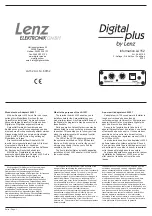
GalileoSky GLONASS/GPS v5.1 (223) User’s Manual
GalileoSky Ltd
Page
21
The second algorithm is always used for remote firmware updating; the Terminal attempts to get the
connection to the server with firmware through SIM 0, and if it fails - through SIM 1.
7.10 GPRS traffic costs optimization
GPRS-traffic costs decrease by online monitoring may be reached by following these advices:
1. Turn off the transmission of unused data, for example temperature, acceleration, analog and digital inputs
values which have no connected sensors. It can be made in the Configurator on Settings/Protocol tab or by
MainPack and HeadPack commands (section Server exchange protocol settings).
2. Increase points record period. It can be made in the Configurator on Settings/Track tab or by WrPeriod
command (section Track parameters settings).
3. Increase turning angle at which the device records a point, and distance at exceed of which the point is
recorded. It can be made in the Configurator on Settings/Tracks tab or by Turning command (section Track
parameters settings).
4. Find out the time of disconnection because of the Terminal inactiveness from the server software
developers. This parameter should be taken into account by points’ record period setting otherwise the
traffic will increase because of costs for restoring connection to the server. Example: points’ record period at
a stop is 1200 seconds (20 minutes), the server disconnection because of the terminal inactiveness is 180
seconds (3 minutes). The Terminal determines that a vehicle has stopped and switches on a timer for the
next point record in 20 minutes, in 3 minutes the server disconnects as it hasn’t received the data from the
Terminal. The Terminal tries to reconnect the server at once. It happens 6 times, and only in 20 minutes the
Terminal sends the next point. As a result, traffic costs considerably exceed savings from points record
interval increase.
5. Set filtering of coordinates at a stop so as the Terminal can correctly chose points’ record period. The
Terminal can determine a stop according to several elements:
accelerometer data (AccSens command, section Track parameters setting);
external supply voltage (MHours command, section Track parameters setting);
ignition sensor indications (Ignition command, section Track parameters setting).
If continuous online monitoring is not necessary, it is possible to set packet data transmission (section Stels
mode and packet data transmission). In this case, the device will periodically contact, send the data from the
blackbox and disconnect from the server. Savings are due to decrease of costs for one data packet
transmission as when sending data from the archive a packet size may be up to 1000 byte, and by online
monitoring usually one point is sent (a few tens of bytes). At the same time, the Terminal operation from the
battery increases as during server disconnection periods the device switches off GSM/3G-unit.
7.11 Operation in international roaming
The Terminal allows setting special parameters of data transmission in the international and national roaming
(Roaming command, section Data transmission settings). After registration in GSM/3G-network the Terminal
receives code of the country and code of the operator from base station and compares them with the set
ones, if they do not match, the Terminal is in roaming. It is possible to specify only code of country
(international roaming) or code of country and code of operator (national roaming). Being in roaming, the
Terminal constantly supports registration in GSM/3G-network but initializes GPRS-session only according to
the schedule, thus it is always possible to make a call to the terminal or send SMS with a command and
decrease GPRS-traffic costs. For GPRS-session the maximum volume of transmitted data in bytes is
determined. Each cellular operator has minimum tariffing interval in roaming, it is recommended to set
maximum data volume equal to half of this interval (the second half is for official traffic TCP/IP, the volume
of which depends on connection quality). By archive transmission from internal flash-memory, the Terminal
always unloads according to the archive settings (FLASHARCHIVE command, section Service commands). By
archive transmission from microSD-card it is recommended to set coordinates transmission and sensors
indications in the first packet, thus the Terminal sends one point with a current vehicle coordinate and the
oldest unloaded archive part. The
data from the microSD-card are unloaded in chronological order.
















































